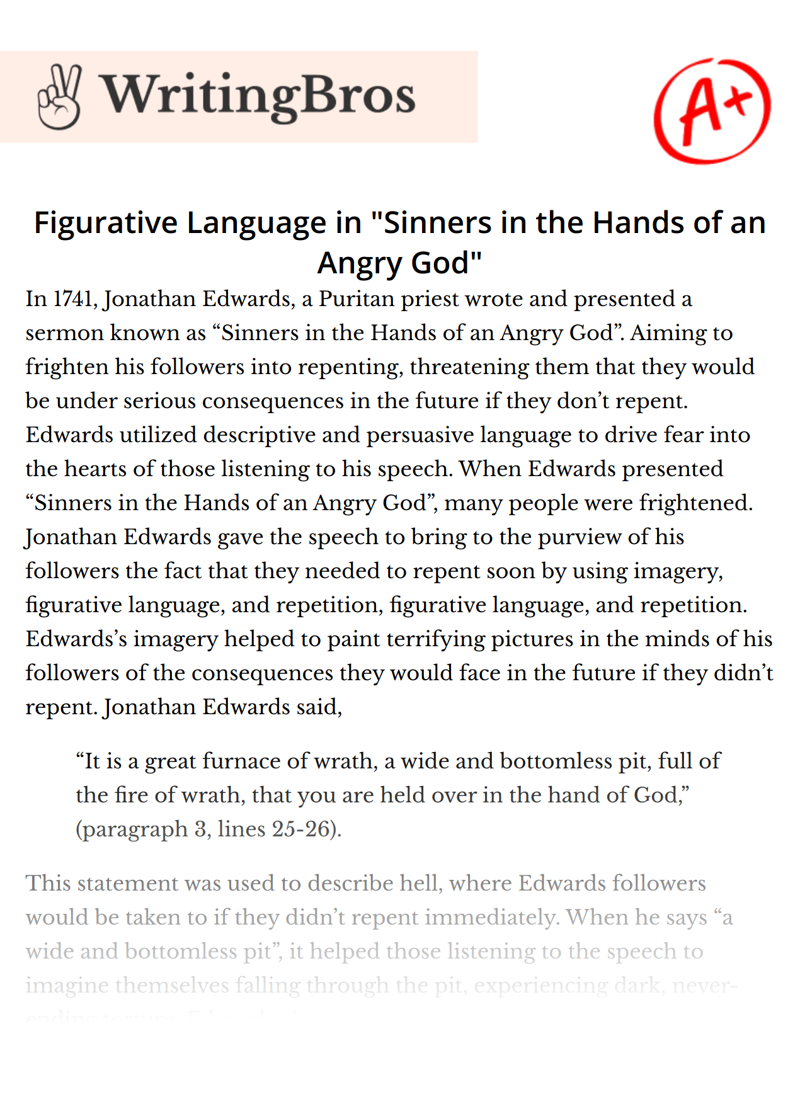Figurative Language in "Sinners in the Hands of an Angry God"

In 1741, Jonathan Edwards, a Puritan priest wrote and presented a sermon known as “Sinners in the Hands of an Angry God”. Aiming to frighten his followers into repenting, threatening them that they would be under serious consequences in the future if they don’t repent. Edwards utilized descriptive and persuasive language to drive fear into the hearts of those listening to his speech. When Edwards presented “Sinners in the Hands of an Angry God”, many people were frightened. Jonathan Edwards gave the speech to bring to the purview of his followers the fact that they needed to repent soon by using imagery, figurative language, and repetition, figurative language, and repetition.
Edwards’s imagery helped to paint terrifying pictures in the minds of his followers of the consequences they would face in the future if they didn’t repent. Jonathan Edwards said,
“It is a great furnace of wrath, a wide and bottomless pit, full of the fire of wrath, that you are held over in the hand of God,” (paragraph 3, lines 25-26).
This statement was used to describe hell, where Edwards followers would be taken to if they didn’t repent immediately. When he says “a wide and bottomless pit”, it helped those listening to the speech to imagine themselves falling through the pit, experiencing dark, never-ending torture. Edwards also uses several other examples of imagery. He states,
“The God that holds you over the pit of hell, much as one holds a spider, or some loathsome insect over the fire, abhors you, and is dreadfully provoked:” (paragraph 2, lines 14-15).
This line told the audience that, they were just like spiders, which are small, insignificant, and gross creatures. Edwards wanted his followers to know that God thought of them as unimportant creatures, just like a spider.
Edwards used repetition for certain parts of the speech that he wanted to make sure his followers would remember. Several times throughout the speech, he says the words “God’s wrath” (paragraph 1, line 1) and “His wrath” (paragraph 2, line 15). He wanted to make sure that his audience understood the fact that God had ways to torture them that they had never thought of before. Edwards was warning the people that “God’s wrath” would be coming for them in no time unless they repented immediately. There were also several other times when Edwards used repetition during his speech. One word that he rephrased several times was “fire” (paragraph 2, lines 15,16,17; paragraph 3, line 26). Fire is so powerful and enticing, yet so threatening and dangerous. Edwards wanted to warn his followers that God had His fire at the ready; the next victim of an evil crime would have to face it.
Jonathan Edwards also used figurative language to warn his followers that they must repent. First, Edwards used similes to get his point across. He stated, “His wrath toward you burns like a fire;” (paragraph 2, line 15). Edwards used the word “fire” to describe how powerful God’s wrath was towards everyone that was disobeying Him. Jonathan felt that God’s wrath was full to the brim with fury and anger towards His people. Edwards also used personification in the speech. He announced to the people, “it is nothing but the mere pleasure of God, and that of an angry God, without any promise or obligation at all, that keeps the arrow one moment from being made drunk with your blood.” (paragraph 1, lines 2-3). Arrows don’t have the capability to become drunk, but Edwards used the phrase to describe the fact that everyone in the audience would be killed if they didn’t change the way they were living immediately. The people listening to the speech became very afraid at the thought of one small, slender arrow “being made drunk with” gallons of blood, coming from all of the people in the room who were being evil.
In conclusion, Jonathan Edwards's sermon, "Sinners in the Hands of an Angry God," was a frightening and persuasive piece of literature that aimed to make his followers repent. Through the use of imagery, repetition, and figurative language, Edwards was able to paint vivid pictures in the minds of his listeners and convey his message of the impending wrath of God. While some may argue that his methods were too extreme or fear-mongering, there is no denying the power of his language and the impact it had on his audience. Ultimately, Edwards's sermon serves as a testament to the power of language and the ability of a skilled orator to move and persuade their listeners.
References
- Edwards, J. (1741). Sinners in the Hands of an Angry God. Timothy Green.
- Martin, R. C. (2005). "Sinners in the Hands of an Angry God" and the Great Awakening: An Analysis of Persuasion. Journal of the Evangelical Theological Society, 48(2), 267-281.
- Lambert, F. (1992). Jonathan Edwards and the Rhetoric of Conversion. University of California Press.
- Stern, J. (2017). Sinners in the Hands of an Angry God: Jonathan Edwards and the Metaphysics of Damnation. Journal of Religious History, 41(2), 219-232.
- Stanger, A. (2005). Metaphysical Context and Content in Jonathan Edwards's "Sinners in the Hands of an Angry God". Literature and Theology, 19(4), 412-423.
- Harlow, R. (2014). Jonathan Edwards' Sermons and the Great Awakening: Religious Satire in "Sinners in the Hands of an Angry God". The Journal of Religion and Popular Culture, 26(1), 1-17.
Cite this Essay
To export a reference to this article please select a referencing style below

